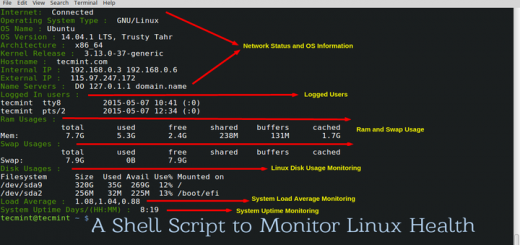5 Shell Scripts for Linux Newbies to Learn Shell Programming – Part II
by Avishek Kumar | Published: July 16, 2013 | July 16, 2013
Download Your Free eBooks NOW - 10 Free Linux eBooks for Administrators | 4 Free Shell Scripting eBooks
To Learn something you need to do it, without the fear of being unsuccessful. I believe in practicality and hence will be accompanying you to the practical world of Scripting Language.
This article is an extension of our First article Understand Linux Shell and Basic Shell Scripting – Part I, where we gave you a taste of Scripting, continuing that we won’t disappoint you in this article.
Script 1: Drawing a Special Pattern
#!/bin/bash
MAX_NO=0
echo -n "Enter Number between (5 to 9) : "
read MAX_NO
if ! [ $MAX_NO -ge 5 -a $MAX_NO -le 9 ] ; then
echo "WTF... I ask to enter number between 5 and 9, Try Again"
exit 1
fi
clear
for (( i=1; i<=MAX_NO; i++ )) do for (( s=MAX_NO; s>=i; s-- ))
do
echo -n " "
done
for (( j=1; j<=i; j++ )) do echo -n " ." done echo "" done ###### Second stage ###################### for (( i=MAX_NO; i>=1; i-- ))
do
for (( s=i; s<=MAX_NO; s++ ))
do
echo -n " "
done
for (( j=1; j<=i; j++ ))
do
echo -n " ."
done
echo ""
done
echo -e "\n\n\t\t\t Whenever you need help, Tecmint.com is always there"
Most of the above ‘key words‘ would be known to you and most of them are self explanatory. e.g., MAXsets the maximum value of the variable, for is a loop and anything within the loop gets on executing again and again till the loop is valid for given value of input.
Sample Output
[root@tecmint ~]# chmod 755 Special_Pattern.sh
[root@tecmint ~]# ./Special_Pattern.sh
Enter Number between (5 to 9) : 6
.
. .
. . .
. . . .
. . . . .
. . . . . .
. . . . . .
. . . . .
. . . .
. . .
. .
.
Whenever you need help, Tecmint.com is always there
If you are a little aware of any programming language, learning the above script is not difficult, even if you are new to computation, programming and Linux it is not going to be much difficult.
Script 2: Creating Colorful Script
Who says, Linux is colorless and boring, save the codes below to anything [dot] sh, make it executable and Run it, don’t forget to tell me how it was, Think what you can achieve, implementing it somewhere.
#!/bin/bash clear echo -e "33[1m Hello World" # bold effect echo -e "33[5m Blink" # blink effect echo -e "33[0m Hello World" # back to normal echo -e "33[31m Hello World" # Red color echo -e "33[32m Hello World" # Green color echo -e "33[33m Hello World" # See remaining on screen echo -e "33[34m Hello World" echo -e "33[35m Hello World" echo -e "33[36m Hello World" echo -e -n "33[0m" # back to normal echo -e "33[41m Hello World" echo -e "33[42m Hello World" echo -e "33[43m Hello World" echo -e "33[44m Hello World" echo -e "33[45m Hello World" echo -e "33[46m Hello World" echo -e "33[0m Hello World"
Note: Don’t bother about the color code now, Those important to you will be at your tongue, gradually.
Warning: Your terminal might not have the facility of blinking.
Sample Output
[root@tecmint ~]# chmod 755 Colorfull.sh [root@tecmint ~]# ./Colorfull.sh Hello World Blink Hello World Hello World Hello World Hello World Hello World Hello World Hello World Hello World Hello World Hello World Hello World Hello World Hello World Hello World
Script 3: Encrypt a File/Directory
This script will encrypt a file (remember? directory/driver/…. everything is treated as file, in Linux). The current limitation of the above script is that it don’t support auto completion of name using TAB. Moreover, you need to place the script and file to be encrypted in the same folder. You may need to install “pinentry-gui”, using yum or apt the package, if required.
[root@midstage ~]# yum install pinentry-gui [root@midstage ~]# apt-get install pinentry-gui
Crete a file called “Encrypt.sh” and place the following script, make it executable and run it as shown.
#!/bin/bash echo "Welcome, I am ready to encrypt a file/folder for you" echo "currently I have a limitation, Place me to thh same folder, where a file to be encrypted is present" echo "Enter the Exact File Name with extension" read file; gpg -c $file echo "I have encrypted the file successfully..." echo "Now I will be removing the original file" rm -rf $file
Sample Output
[root@tecmint ~]# chmod 755 Encrypt.sh
[root@tecmint ~]# ./Encrypt.sh
Welcome, I am ready to encrypt a file/folder for you
currently I have a limitation, Place me to the same folder, where a file to be
encrypted is present
Enter the Exact File Name with extension
package.xml
┌─────────────────────────────────────────────────────┐
│ Enter passphrase │
│ │
│ │
│ Passphrase *******_________________________________ │
│ │
│ <OK> <Cancel> │
└─────────────────────────────────────────────────────┘
Please re-enter this passphrase
┌─────────────────────────────────────────────────────┐
│ Please re-enter this passphrase │
│ │
│ Passphrase ********________________________________ │
│ │
│ <OK> <Cancel> │
└─────────────────────────────────────────────────────┘
I have encrypted the file successfully...
Now I will be removing the original file
</pre>
gpg -c : This will encrypt your file, using a passkey aka password. In this process of learning you would have never thought that the actual process of learning could be that much easy. So after encrypting a file what you need? Obviously! decrypting the file. And I want you – the learner, the reader to write the decryption script yourself, don’t worry I am not leaving you in the middle, I just want you to gain something out of this article.
Note: gpg -d filename.gpg > filename is what you need to implement in your decryption script. You may post you script in comment if successful, if not you may ask me to write it for you.
Script 4: Checking Server Utilization
Checking the server utilization is one of the important task of an administrator, and a good administrator is one who knows how to automate his day to day task. Below is the script that will give many such information about your server. Check it yourself.
#!/bin/bash
date;
echo "uptime:"
uptime
echo "Currently connected:"
w
echo "--------------------"
echo "Last logins:"
last -a |head -3
echo "--------------------"
echo "Disk and memory usage:"
df -h | xargs | awk '{print "Free/total disk: " $11 " / " $9}'
free -m | xargs | awk '{print "Free/total memory: " $17 " / " $8 " MB"}'
echo "--------------------"
start_log=`head -1 /var/log/messages |cut -c 1-12`
oom=`grep -ci kill /var/log/messages`
echo -n "OOM errors since $start_log :" $oom
echo ""
echo "--------------------"
echo "Utilization and most expensive processes:"
top -b |head -3
echo
top -b |head -10 |tail -4
echo "--------------------"
echo "Open TCP ports:"
nmap -p- -T4 127.0.0.1
echo "--------------------"
echo "Current connections:"
ss -s
echo "--------------------"
echo "processes:"
ps auxf --width=200
echo "--------------------"
echo "vmstat:"
vmstat 1 5
Sample Output
[root@tecmint ~]# chmod 755 Server-Health.sh
[root@tecmint ~]# ./Server-Health.sh
Tue Jul 16 22:01:06 IST 2013
uptime:
22:01:06 up 174 days, 4:42, 1 user, load average: 0.36, 0.25, 0.18
Currently connected:
22:01:06 up 174 days, 4:42, 1 user, load average: 0.36, 0.25, 0.18
USER TTY FROM LOGIN@ IDLE JCPU PCPU WHAT
tecmint pts/0 116.72.134.162 21:48 0.00s 0.03s 0.03s sshd: tecmint [priv]
--------------------
Last logins:
tecmint pts/0 Tue Jul 16 21:48 still logged in 116.72.134.162
tecmint pts/0 Tue Jul 16 21:24 - 21:43 (00:19) 116.72.134.162
--------------------
Disk and memory usage:
Free/total disk: 292G / 457G
Free/total memory: 3510 / 3838 MB
--------------------
OOM errors since Jul 14 03:37 : 0
--------------------
Utilization and most expensive processes:
top - 22:01:07 up 174 days, 4:42, 1 user, load average: 0.36, 0.25, 0.18
Tasks: 149 total, 1 running, 148 sleeping, 0 stopped, 0 zombie
Cpu(s): 0.1%us, 0.0%sy, 0.0%ni, 99.3%id, 0.6%wa, 0.0%hi, 0.0%si, 0.0%st
PID USER PR NI VIRT RES SHR S %CPU %MEM TIME+ COMMAND
1 root 20 0 3788 1128 932 S 0.0 0.0 0:32.94 init
2 root 20 0 0 0 0 S 0.0 0.0 0:00.00 kthreadd
3 root RT 0 0 0 0 S 0.0 0.0 0:14.07 migration/0
Note: I have given you the script that gives the output in the terminal itself, how about getting the output in a file for future reference. Implement it using redirect operator.
- ‘>‘ : the redirection operator causes a file creation, and if it does exist, the contents are overwritten.
- ‘>>‘ : when you use >>, you are adding information, rather than replacing it.
- ‘>>‘ is safe, as compared to ‘>‘
Script 5: Check Disk Space and Sends an Email Alert
How about getting an email when disk use in partition PART is bigger than Maximum allowed, it is a life saver script for web administrators with little modification.
MAX=95
EMAIL=USER@domain.com
PART=sda1
USE=`df -h |grep $PART | awk '{ print $5 }' | cut -d'%' -f1`
if [ $USE -gt $MAX ]; then
echo "Percent used: $USE" | mail -s "Running out of disk space" $EMAIL
fi
Note: Remove “USER” with your user name. You can check mail using using ‘mail‘ command.
Script writing and programming is beyond boundaries, anything and everything could be implemented as required. That’s all for now, In my very next article I will be giving your some different flavors of scripting. Till then stay cool and tuned, enjoy.
If you have any questions or problems regarding this article and want help within 24 Hours? Ask Now
Support TecMint: Did you find this tutorial helpful?. Please help to keep it alive by donating. Every cent counts! - Donate Now
Avishek Kumar
I am a major in computer science, love to research nix. I love to write codes and scripts, review distros, experiment Foss Technologies, write technical articles, Hack, of course Ethically. I am working as System Administrator (nix) for a NGO.
Your name can also be listed here. Got a tip? Submit it here to become an TecMint author.
Receive Your Free Complimentary eBook NOW! - Can You Run It On Linux? 10 Vital Apps You Will Want When You Switch
- NEXT STORYVnStat PHP: A Web Based Interface for Monitoring Network Bandwidth Usage
- PREVIOUS STORYInstall TightVNC Server in RHEL/CentOS and Fedora to Access Remote Desktops
YOU MAY ALSO LIKE...
70 RESPONSES
LEAVE A REPLY
DOWNLOAD FREE LINUX EBOOKS
- Complete Linux Command Line Cheat Sheet
- The GNU/Linux Advanced Administration Guide
- Securing & Optimizing Linux Servers
- Linux Patch Management: Keeping Linux Up To Date
- Introduction to Linux – A Hands on Guide
- Understanding the Linux® Virtual Memory Manager
- Linux Bible – Packed with Updates and Exercises
- A Newbie’s Getting Started Guide to Linux
- Linux from Scratch – Create Your Own Linux OS
- Linux Shell Scripting Cookbook, Second Edition
- Securing & Optimizing Linux: The Hacking Solution
- User Mode Linux – Understanding and Administration



Drawing a Special Pattern: Throwing an error
./pattern.sh: 19: ./pattern.sh: Syntax error: Bad for loop variable
simply by executing of the below commans
$ stat /path/to/file/file_name
$ ls -l /path/to/file/file_name
$ ls -lc /path/to/file/file_name
$ ls -lu /path/to/file/file_name
$ stat /path/to/file/file_name /path/to/file2/file_name2
$ ls -l /path/to/file/file_name /path/to/file2/file_name2
$ ls -lc /path/to/file/file_name /path/to/file2/file_name2
$ ls -lu /path/to/file/file_name /path/to/file2/file_name2